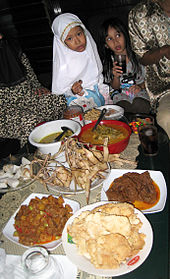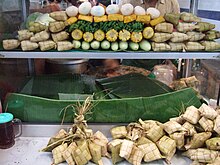Ketupat
Ketupat is related to similar dishes in other rice-farming Austronesian cultures, like the Filipino pusô or Patupat, although the latter is not restricted to diamond shapes and traditionally come in various intricately woven designs ranging from star-like to animal-shaped.
[8][9] The use of woven young palm leaves (janur) fronds as a pouch to cook food is widespread in Maritime Southeast Asia, from Java, Indonesia to Malaysia, Singapore, and the Philippines.
The oldest manuscript mentioning ketupat is found in the Kakawin Ramayana, written in the 9th century during the reign of King Balitung, the era of the Mataram kingdom.
[10] Despite its current association with Muslim festival of lebaran, ketupat is also known in non-Muslim communities, such as Hindu Balinese,[11] Javanese Kejawen beliefs, and people of the Philippines, which suggested that the weaving of coconut fronds has pre-Islamic origin.
[15] The tradition on preparing and consuming ketupat or kupat in Javanese language during lebaran was introduced by Raden Mas Sahid or Sunan Kalijaga,[16] one of Wali Songo (nine Muslim saints) that spread Islam in Java.
It is believed that it contains appropriate symbolism; kupat means ngaku lepat or "admitting one's mistakes" in Javanese language,[15] in accordance to asking for forgiveness tradition during lebaran.
[16] Other than Java, the tradition on consuming ketupat during Eid ul-Fitr is also can be found throughout Indonesia; from Sumatra, Kalimantan, Sulawesi, Nusa Tenggara, and also neighboring countries, including Malaysia, Singapore and Brunei.
[12] The coco leaves used in wrapping the rice are always shaped into a triangular or diamond form and stored hanging in bunches in the open air.
In Colo, Kudus Regency, a parade of gunungan (cone-shape offering) made of ketupat, lepet and other food items on the slope of Mount Muria near the grave of noted Muslim preacher Sunan Muria, was held to celebrate Bada Kupat, while on the slope of Mount Merapi in Boyolali Regency, the celebration featured a parade of livestock decorated with ketupat.
[6] Among Hindu communities in Bali and Banyuwangi in East Java, ketupat is part of the offering and ritual of Kuningan festive celebration to conclude the Galungan holy days.
During Galungan, Hindu families create and erect a penjor pole made of janur (young palm leaves), and then make some offerings to the Pura.
[17] Ketupat is also traditionally served by Indonesian and Malays at open houses on festive occasions such as lebaran or Idul Fitri (Hari Raya Aidilfitri).
It consist of ketupat served with sliced labu siam (chayote) and unripe jackfruit gulai in thin and spicy coconut milk soup, topped with cooked tofu and telur pindang (spiced boiled egg), and krupuk crackers.
Its Balinese version is called tipat cantok, which is sliced ketupat with boiled or blanched vegetables; asparagus bean, water spinach, bean sprout, cucumber, and fried tofu mixed in peanut sauce which is made from ground fried peanuts, garlic, chili pepper, salt and tauco fermented soy paste.
[11] In Java, among traditional Muslim abangan community, the woven empty or uncooked ketupat skin is often hung as an amulet to symbolise wealth and prosperity.
In the Philippines, similar rice pouches are known as puso (literally "heart") and had their origins from pre-colonial animistic ritual offerings as recorded by Spanish historians.
Unlike ketupat, however, they are not restricted to diamond shapes and can come in a wide variety of weaving styles (including bird and other animal forms) which still survive among various ethnic groups in the Philippines today.
[7] In Cambodia, a similar dish of pounded sticky rice wrapped in a pentagonal woven palm leaves is called katom (កាតំ) in Khmer.













